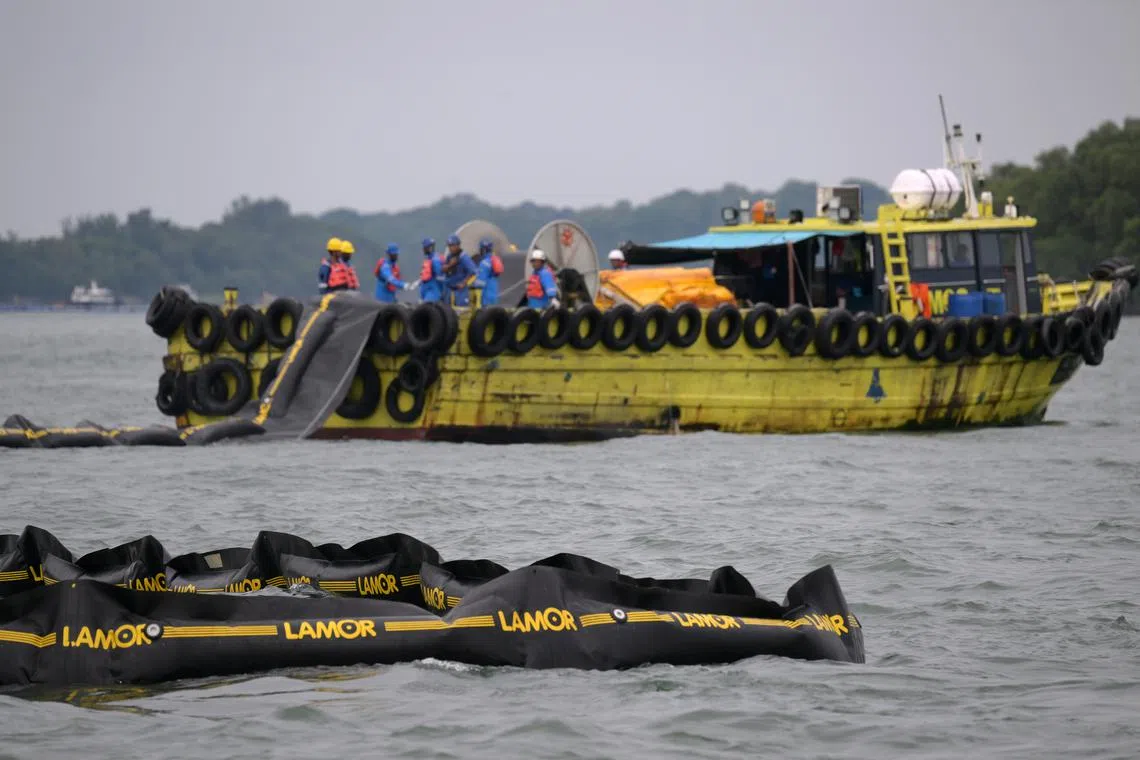Have booms at anchorage, more frequent drills to mitigate oil spills, other incidents: Ship captains
Sign up now: Get ST's newsletters delivered to your inbox

Curtain booms being lowered into the sea off Siloso Beach in Sentosa on June 21.
ST PHOTO: NG SOR LUAN
Follow topic:
SINGAPORE – In the wake of the recent maritime incident
The Straits Times spoke to two current ship captains and a former captain, who have 10 to 30 years of sailing experience, on possible improvements to existing practices.
Captain A, 61, who has close to 30 years of experience, said a pre-emptive measure to contain oil spills would be placing containment booms around ships at anchorages – designated areas in harbours or ports where ships can drop anchor while waiting to berth. He requested anonymity due to company policy restricting crew members from speaking to the media.
His suggestion takes a cue from some ports in the US and Netherlands, which place these floating devices at anchorages to act as a barrier to trap oil within a certain area in the event of a spill.
ST has reached out to the Maritime and Port Authority of Singapore (MPA) for comment on its existing protocols, as well as potential adjustments to its measures. Port operator PSA Singapore redirected queries about the roll-out of pre-emptive containment booms to MPA.
Mandated by international maritime safety standards, ship crews need to participate in regular drills to practise responding to various emergencies, said Captain Sahwan Osman, a senior lecturer at Singapore Polytechnic’s Singapore Maritime Academy.
He noted that steering gear failure drills are conducted at least once every one to three months, while monthly engine failure drills are tabletop discussions involving all members on board.
Captain Sahwan, who sailed for 10 years and has been teaching for 19 years, proposed that ship crews conduct drills more regularly than regulations require.
As a young ship cadet, his then captain conducted emergency evacuation drills every Saturday instead of at the mandated frequency of once a month, which helped to familiarise him with the steps, the 61-year-old said.
Compounded challenges
The three captains said navigating Singapore’s waters comes with its own set of challenges as its waterways are surrounded by outlying islands and neighbouring countries.
Furthermore, Singapore’s port has high vessel traffic, on top of having anchorages located close to one another.
Captain Sahwan said the Sinki Fairway that ships coming from the Strait of Malacca have to sail through to get to Pasir Panjang Terminal is narrow and busy, and vessels need to carefully manoeuvre around islands such as St John’s and Lazarus.
Captain B, 40, who has 12 years of maritime experience, said the high congestion makes navigating Singapore’s waters a challenge without a harbour pilot providing clear instructions to the ship’s captain.
A harbour pilot is a local ship-handling specialist who goes on board a foreign-flagged vessel to guide it safely in and out of ports.
The Netherlands-flagged Vox Maxima was under pilotage when it suffered a sudden loss of engine and steering control
It hit the stationary Singapore-flagged bunker vessel Marine Honour, rupturing one of its oil tanks, leading to the oil spill that is still being cleaned up.
Captain A said such a disabled vessel in port can lead to “disastrous” consequences.
Risks include colliding into other vessels and hitting wharves or harbour structures, added Captain Sahwan, while a vessel that has lost engine control could run into shallow waters, leading to a loss of propulsion.
As the entrances to Singapore’s waters are quite narrow and busy, a vessel breakdown may also block shipping traffic and affect port operations, he said.
Ports in bigger countries, such as Japan and China, have larger waterfronts, and a vessel breakdown has less significant repercussions than one in Singapore.
Crisis management
Captain B noted that ships must meet safety, environmental and operational standards in foreign ports, so they must carry out effective maintenance of their engines and steering controls.
But this is not always foolproof, he added, as a new ship may also run into such issues, given the complexity of equipment on board.
Still, a sudden loss in engine and steering control of a vessel is rare, said all three captains, who said they have experienced this only one to three times in their career.
Over his 10 years of sailing, Captain Sahwan experienced an engine failure near a port only once. As he was on a dual-engine ferry, he could continue manoeuvring the vessel using the other engine.
On the other two occasions, he was out at sea and there were no other vessels nearby. This meant that the vessel could drift freely while the engineers fixed the system.
Every vessel has its own safety management system or standard operating procedures for emergency situations.
Captain A said that if his ship or vessel loses engine and steering control, the crew has been trained to drop anchors instantly and to inform the port of the situation.
At the same time, the ship would begin emergency steering, which involves the crew going down into the steering flat, or a steering gear room, to navigate the vessel from its internal mechanisms, he added.
Captain Sahwan said the crew would need to make an announcement on the ship’s very high frequency radio system to warn other ships about the emergency, and to indicate that it is not under command.
Captain A said that, depending on the vessel, it could take around five minutes to complete the steps stipulated in the standard operating procedures if the vessel was initially moving at a safe speed of 4 to 8 knots.

